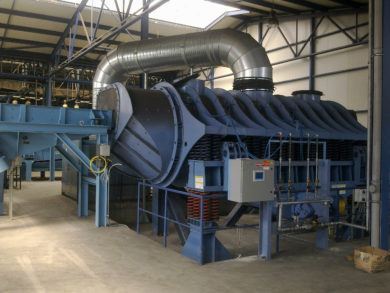Commercial vibratory equipment is used to handle all kinds of products including automotive parts and building materials as well as for resource separation, mining recovery and much more. But before vibratory equipment became recognized, many processes took much longer and had to be done manually. Let’s first look at vibratory equipment in the metal casting industry, how it’s used and how it has evolved.
Metal Casting Before Vibratory Equipment

Metal casting has been used for thousands of years to create art, weapons, and tools. Today, the casting process uses vibratory equipment to ensure foundrymen safety and to produce castings more efficiently.
Many modern metal casters use sand and bonding agents to create molds. Materials that can be reused in another casting, like sand, can be reclaimed and reconditioned using equipment like the VIBRA-DRUM® Sand & Casting Conditioner. However, industries only began using vibratory equipment widely in the 20th century, after commercial machines were introduced in the 1800s.
Before foundries began using commercial vibratory equipment to automate the casting process, much of it was done by hand. Small crucible ovens, one of the oldest types of melting ovens, were used to melt casting materials like copper, tin, and lead alloys. Metal materials were likely fed into ovens by workers, rather than using equipment like a Furnace Charge Feeder to move large quantities safely.
Single-use molds made of foam and clay and permanent molds of stone and metal were used to create objects. Liquid metal was poured by workers into molds using tongs. Anything involving an assembly line or conveyor belt to move materials from point A to point B was done by workers.
Mining and Salvaging Before Vibratory Equipment
When it comes to mixed waste processing and mining, the entire process was much more difficult before the invention of vibratory equipment. Solutions like water baths and hand-picking were much more common, requiring high labor for even simple materials. Sorting required manual screens and sifters throughout much of the 19th century and workers had horses (or themselves) to carry heavy materials. In some cases, they would create a “conveyor belt” style system with sluices to carry materials from the mining location into basins of water, where much of the material was reclaimed.
More often than not, sorting and processing of most materials required uneconomical labor and time before vibratory technology was utilized. Many valuable products went unsalvaged and were thrown away or dumped.
Technological Advancements in Vibratory Equipment
Today, the use of commercial vibratory equipment has improved the health and safety conditions of our workers. Today’s vibratory equipment is not only efficient in the use of materials, production time, output, and material reclamation, but are engineered to be energy-efficient and run quieter than ever before. Minimizing exposure to health hazards has come a long way to protect worker health.
Have a question or challenge for us? Contact one of General Kinematics’ offices or ask us a question online.








